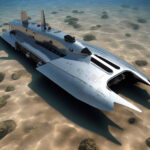US’ Next Gen Hypersonic Missile Defense Counters Advanced Maneuvering Targets
The United States recently tested anti-hypersonic defense tactics to counter the threat posed by hypersonic missiles. As countries around the world continue to advance their missile technology, the need for robust defense systems has become increasingly urgent. Hypersonic missiles are capable of traveling at speeds exceeding Mach 5, making them extremely difficult to intercept using traditional missile defense systems. In response to this growing threat, the US has been developing next-generation hypersonic missile defense systems that are specifically designed to counter advanced maneuvering targets.
One of the key challenges in intercepting hypersonic missiles lies in their speed and maneuverability. Unlike traditional ballistic missiles that follow a predictable trajectory, hypersonic missiles can change course mid-flight, making them extremely difficult to track and intercept. To address this challenge, the US has been investing in advanced radar systems and interceptor technologies that are capable of detecting and neutralizing hypersonic threats in real-time.
One of the most promising developments in this area is the use of directed energy weapons, such as high-energy lasers, to intercept hypersonic missiles. These weapons have the advantage of traveling at the speed of light, making them much faster than traditional interceptors. In a recent test, the US successfully used a high-energy laser to shoot down a test target simulating a hypersonic missile. This demonstration marked a significant milestone in the development of next-generation missile defense systems.
In addition to directed energy weapons, the US is also exploring other innovative technologies to counter hypersonic threats. One such technology is the use of autonomous drones equipped with advanced sensors and interceptors. These drones can be deployed to quickly respond to incoming threats and provide an additional layer of defense against hypersonic missiles. By leveraging the speed and agility of drones, the US aims to create a more robust and resilient missile defense system.
Furthermore, the US is working closely with its allies to enhance collective defense capabilities against hypersonic threats. By sharing technology and intelligence, the US and its partners can better coordinate their efforts to counter the evolving threat landscape. This collaborative approach not only strengthens regional security but also fosters greater interoperability among allied forces.
As the arms race in hypersonic missile technology continues to escalate, the US remains committed to staying ahead of the curve. By investing in cutting-edge defense systems and fostering international partnerships, the US is positioning itself to effectively counter the threat posed by hypersonic missiles. With ongoing testing and development efforts, the future of missile defense looks promising, offering a glimmer of hope in an increasingly complex security environment.
In conclusion, the United States’ next-generation hypersonic missile defense systems represent a significant leap forward in countering advanced maneuvering targets. By harnessing innovative technologies and fostering international cooperation, the US is paving the way for a more secure future in an era of hypersonic threats.
hypersonic missiles, missile defense, advanced technology, US defense systems, international cooperation












